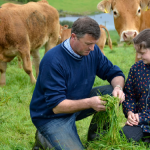Each month, an IFA Smart Farming Case Study is published…
Smart Farming case study – dairy farmer Andrew McHugh
[vc_row][vc_column][vc_column_text]The Smart Farming programme focuses on eight key areas that have the highest costs on farms, or offer the greatest savings to farmers. In this case study, Thomas Ryan tells us about a dairy farm owned by Andrew McHugh, who saved over €9,000. Andrew presented this case study to the Citizens Convention on Climate Change in 2017.
Andrew and his family are dairy farmers and live near Newtownforbes in County Longford. Andrew took part in the Smart Farming programme which helped him to identify cost savings on his farm of over €9,000.
Andrew is also on a pathway to reducing his climate impact by 20%, using the results of the Teagasc and Bord Bia Carbon Navigator decision support tool outlined in the Winter 2017 Catchments Newsletter. The following five areas were examined on Andrew’s farm, to identify ways to reduce greenhouse gas emissions: grazing season length, herd breeding strategy, improved nitrogen efficiency, improved slurry management and better energy use.
Grazing season length
Using the Carbon Navigator decision support tool, Andrew can reduce his emissions by 0.8% by increasing the grazing season length by one week in March and November, as grazed grass in the early and late grazing season is a higher quality more digestible feed than grass silage, leading to reductions in the proportion of dietary energy lost as methane (CH4). Also, the shorter housing season leads to reduced slurry methane and nitrous oxide (N2O) emissions from storage and energy use from spreading.
Herd breeding strategy
The largest (-15%) reduction in greenhouse gas emissions identified on Andrew’s farm when using the Carbon Navigator decision support tool was by increasing the genetic merit of his herd. Increasing genetic merit by using the Economic Breeding Index (EBI) has the capacity to reduce emissions through four mechanisms:
- Improving fertility reduces calving intervals and replacement rates, thus reduces enteric CH4 emissions per unit of product
- Increasing milk yield per unit of grazed grass and improving milk composition increases the efficiency of production, which decreases emissions per unit of product
- Earlier and more compact calving increases the proportion of grazed grass in the diet and reduces culling and replacement rates
- Improved survival and health reduces deaths and disease incidences, reduces replacement rates and emissions
Andrew’s current EBI figures have scope for improvement and thereby reducing greenhouse gas emissions. This is because dairy cows that are milking for three seasons or longer in Andrew’s herd are currently trailing the national EBI average. Andrew’s focus over the coming years will be to target his breeding strategy on improving the genetic metric of his herd by using the EBI index to breed for improved performance (yield and fertility).
Improved nitrogen efficiency
Andrew can reduce his greenhouse gas emissions by almost 3% by increasing nitrogen efficiency. Andrew will be focusing on the following areas:
- The increased use of clover in swards thereby reducing N usage
- Better soil fertility management
- Effective grazing management leading to high levels of grass production and utilisation
- Improvements in the timing and application of fertiliser nitrogen
- The application of the most appropriate N fertiliser type for the prevailing conditions (urea v CAN)
Improved slurry management
The Carbon Navigator has identified that by improving manure management Andrew can reduce greenhouse gas emissions associated with manure by almost 2%, through a transition from summer application to spring application of manure and the use of low-emission application methods.
Spring application reduces ammonia emissions (NH3) following land spreading due to the more favourable weather conditions at that time of year. It also increases the fertiliser replacement of slurry. Therefore, the total fertiliser nitrogen input and associated emissions from manufacturing, spreading and storage are reduced.
Better energy management
While energy usage accounts for a relatively small amount of total system emissions on dairy farms, the Carbon Navigator has identified that Andrew can reduce his greenhouse gas emissions by almost 1%. Three key areas are identified as having significant potential to reduce energy related emissions:
- Effective pre-cooling in a Plate Heat Exchanger
- The use of Variable Speed Drive (VSD) Vacuum Pumps
- Presence of energy efficient water heating systems
Each of these three areas were relevant for Andrew, however the Smart Farming study drew Andrew’s attention to the need to resize his plate heat exchanger.
Energy production, forestry and biodiversity
In addition to using the Carbon Navigator decision support tool Andrew would like move to an energy neutrality position on his farm, whereby he is using the shed roofs and manures for renewable energy production. The lack of necessary stimulus measures from the Department of Communications, Climate Action and Environment is holding back the potential for farm scale renewable energy production.
Andrew would also like to complement his existing dairy farming enterprise by developing an agro-forestry and biodiversity strategy for his farm, which would allow him plant certain parts of his farm. However, the compulsory re-planting obligation, restrictions on planting and administrative burdens around the forestry roads scheme all act as barriers to supporting the development of an agro-forestry strategy on Andrew’s farm.
Farmers providing leadership
Smart Farming is one means by which the agriculture sector in Ireland, and particularly farmers themselves, are endeavouring to provide leadership in addressing climate change. The programme draws on the expertise of the sector and complements other knowledge transfer programmes such as Better Farms, PastureBase Ireland and Dairy Sustainability Ireland.
Are you ready to take the Smart Farming challenge?
Are you ready to take the Smart Farming challenge? We are currently recruiting farmers, who may be interested in taking part in 2018. Let’s talk smartfarming@ifa.ie and 01-4260343
Thomas Ryan, IFA
Watch Andrew’s presentation to the Citizen’s Assembly on Climate Change:
www.smartfarming.ie/case-studies/andrew-mchugh/[/vc_column_text][/vc_column][/vc_row][vc_row][vc_column][vc_video link=”https://www.youtube.com/watch?v=etpQTrzq2uM”][/vc_column][/vc_row][vc_row][vc_column][vc_gallery interval=”3″ images=”3043,3064″ img_size=”large”][/vc_column][/vc_row]







